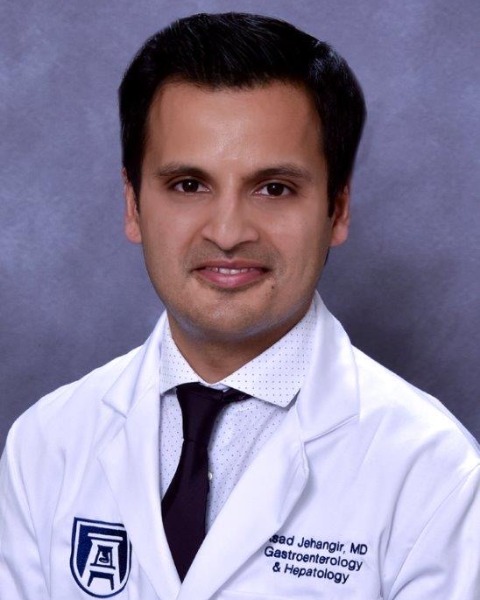Back


Poster Session B - Monday Morning
Category: General Endoscopy
B0290 - Holy Cow! When Cecal “Polypectomy” Specimen Shows Cow’s Liver
Monday, October 24, 2022
10:00 AM – 12:00 PM ET
Location: Crown Ballroom

Has Audio

Asad Jehangir, MD
MD
Augusta, GA
Presenting Author(s)
Rohma Qureshi, MS1, Asad Jehangir, MD2, Dariush Shahsavari, MD3, Intisar Ghleilib, MD4, Subbaramiah Sridhar, MBBS, MPH5, John Erikson L. Yap, MD6
1Shalamar Medical & Dental College, Lahore, Punjab, Pakistan; 2MD, Augusta, GA; 3Medical College of Georgia - Augusta University, Augusta, GA; 4Medical College of Georgia at Augusta University, Augusta, GA; 5Medical College of Georgia, Augusta, GA; 6Augusta University Medical College of Georiga, Augusta, GA
Introduction: Patients with history of colon tubular adenomas need surveillance colonoscopies to decrease the risk of colon neoplasia. Sometimes, contamination of polypectomy specimen with ingested food can create confusion while interpreting the results. We present an interesting case of a cecal "polypectomy" specimen that showed liver tissue, that on further investigation was attributed to a cow's liver that the patient ingested the day before his procedure.
Case Description/Methods: A 72-year-old Caucasian male with past medical history of colon tubular adenomas, chronic constipation, hypertension, obstructive sleep apnea and class III obesity was referred for surveillance colonoscopy. His constipation was well-controlled with linaclotide 72 mcg daily. He did not report any hematochezia or weight loss. His physical examination including vital signs and abdominal examination was unremarkable. Colonoscopy was performed after a 4-liter polyethylene glycol bowel preparation which revealed three polyps. These included a 5 mm Paris 0-1s polyp which was removed via cold snare polypectomy (Image 1A), and two 2 mm sessile polyps in the ascending and descending colon (removed via biopsy forceps). The ascending and descending colon polyps were tubular adenomas on histological examination. We were notified by the reading pathologist that the cecal "polyp" showed liver tissue (Images 1B-C) with the concern for iatrogenic perforation of the colon during colonoscopy and accidental biopsy of patient's liver. The patient denied any symptoms suggestive of colonic perforation. Upon further discussion, he informed us that he ate fried cow's liver the day before the procedure which was inadvertently suctioned in the trap after cold snare polypectomy of his cecal polyp.
Discussion: Identification of liver tissue in colonoscopy polypectomy specimens should raise possibility of catastrophic complication such as a perforation or simply a possibility of contamination of specimen with ingested food. Following-up with the patient to clarify the situation is important. A careful review of patient’s dietary intake before the colonoscopy procedure can help correctly interpret the unexpected pathology results.

Disclosures:
Rohma Qureshi, MS1, Asad Jehangir, MD2, Dariush Shahsavari, MD3, Intisar Ghleilib, MD4, Subbaramiah Sridhar, MBBS, MPH5, John Erikson L. Yap, MD6. B0290 - Holy Cow! When Cecal “Polypectomy” Specimen Shows Cow’s Liver, ACG 2022 Annual Scientific Meeting Abstracts. Charlotte, NC: American College of Gastroenterology.
1Shalamar Medical & Dental College, Lahore, Punjab, Pakistan; 2MD, Augusta, GA; 3Medical College of Georgia - Augusta University, Augusta, GA; 4Medical College of Georgia at Augusta University, Augusta, GA; 5Medical College of Georgia, Augusta, GA; 6Augusta University Medical College of Georiga, Augusta, GA
Introduction: Patients with history of colon tubular adenomas need surveillance colonoscopies to decrease the risk of colon neoplasia. Sometimes, contamination of polypectomy specimen with ingested food can create confusion while interpreting the results. We present an interesting case of a cecal "polypectomy" specimen that showed liver tissue, that on further investigation was attributed to a cow's liver that the patient ingested the day before his procedure.
Case Description/Methods: A 72-year-old Caucasian male with past medical history of colon tubular adenomas, chronic constipation, hypertension, obstructive sleep apnea and class III obesity was referred for surveillance colonoscopy. His constipation was well-controlled with linaclotide 72 mcg daily. He did not report any hematochezia or weight loss. His physical examination including vital signs and abdominal examination was unremarkable. Colonoscopy was performed after a 4-liter polyethylene glycol bowel preparation which revealed three polyps. These included a 5 mm Paris 0-1s polyp which was removed via cold snare polypectomy (Image 1A), and two 2 mm sessile polyps in the ascending and descending colon (removed via biopsy forceps). The ascending and descending colon polyps were tubular adenomas on histological examination. We were notified by the reading pathologist that the cecal "polyp" showed liver tissue (Images 1B-C) with the concern for iatrogenic perforation of the colon during colonoscopy and accidental biopsy of patient's liver. The patient denied any symptoms suggestive of colonic perforation. Upon further discussion, he informed us that he ate fried cow's liver the day before the procedure which was inadvertently suctioned in the trap after cold snare polypectomy of his cecal polyp.
Discussion: Identification of liver tissue in colonoscopy polypectomy specimens should raise possibility of catastrophic complication such as a perforation or simply a possibility of contamination of specimen with ingested food. Following-up with the patient to clarify the situation is important. A careful review of patient’s dietary intake before the colonoscopy procedure can help correctly interpret the unexpected pathology results.

Figure: Figure 1A: Paris 0-1s 5 mm cecal polyp during surveillance colonoscopy. Figure 1B: At low power the section shows an eosinophilic homogenous tissue without surface epithelium. Figure 1C: At higher power: sheets of polygonal cells with round, centrally located nuclei, and abundant eosinophilic cytoplasm compatible with hepatocytes. The hepatocytes arranged in plates extend from central vein to portal triad.
Disclosures:
Rohma Qureshi indicated no relevant financial relationships.
Asad Jehangir indicated no relevant financial relationships.
Dariush Shahsavari indicated no relevant financial relationships.
Intisar Ghleilib indicated no relevant financial relationships.
Subbaramiah Sridhar indicated no relevant financial relationships.
John Erikson Yap indicated no relevant financial relationships.
Rohma Qureshi, MS1, Asad Jehangir, MD2, Dariush Shahsavari, MD3, Intisar Ghleilib, MD4, Subbaramiah Sridhar, MBBS, MPH5, John Erikson L. Yap, MD6. B0290 - Holy Cow! When Cecal “Polypectomy” Specimen Shows Cow’s Liver, ACG 2022 Annual Scientific Meeting Abstracts. Charlotte, NC: American College of Gastroenterology.
